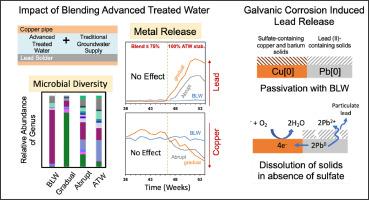Impacts of blending advanced treated water and traditional groundwater supply on lead and copper concentrations and microbial diversity in premise plumbing
IF 12.4
1区 环境科学与生态学
Q1 ENGINEERING, ENVIRONMENTAL
引用次数: 0
Abstract
In response to stresses on water demands, some regions augment conventional drinking water sources with alternative water supplies such as desalinated seawater and reclaimed wastewater. The advanced treatment of wastewater by reverse osmosis, microfiltration, and advanced oxidation processes can produce high quality water for potable uses. However, if not appropriately stabilized, the resulting water can be corrosive to metal-based distribution pipes and plumbing materials. We conducted long-term premise plumbing pipe loop experiments with copper pipes containing lead solder to test the impact of the introduction of advanced treated water on the water quality. Advanced treated water (ATW) originally at low pH (<7) and low alkalinity (<10 mg/L as CaCO3) was stabilized with a calcite contactor before being blended with baseline ground water (BLW). The effects of percentages of ATW on the release of lead and copper and on the changes in the microbial diversity were monitored. Experiments monitored metal release from pipes receiving (1) only BLW, (2) a series of blends of BLW and ATW that gradually increased from 25 % to 100 % ATW, and (3) an abrupt switch from BLW to 100 % ATW. Introducing 100 % ATW dramatically increased lead release and simultaneously decreased copper release. Pipe scale analysis showed that the introduction of ATW had destabilized sulfate-containing pipe scales, which exposed the copper pipe surface to galvanic corrosion. The dissolution of scale material was associated with a significant decrease in sulfate concentration in the 100 % ATW which was in agreement with theoretical solubility calculations. The impact of blending ATW on microbial diversity was studied via 16S rRNA gene amplicon sequencing. The composition of the microbial communities changed significantly after water was in contact with the copper pipes in experiments with both BLW and ATW. The type of water recirculating in the pipes affected the structure of the microbial community. The results from this study can be useful for water utilities that are considering potable reuse as they develop strategies to mitigate any adverse impacts of water quality changes.


高级处理水与传统地下水混合供水对楼宇冷热水管道中铅和铜浓度以及微生物多样性的影响
为了应对水资源需求的压力,一些地区利用海水淡化和再生废水等替代水源来增加传统的饮用水源。通过反渗透、微过滤和高级氧化工艺对废水进行高级处理,可以生产出高质量的饮用水。但是,如果不进行适当的稳定化处理,产生的水可能会腐蚀以金属为基础的输水管道和冷热水管道材料。我们用含铅焊料的铜管进行了长期的前提下冷热水管道循环实验,以测试引入高级处理水对水质的影响。高级处理水(ATW)的pH值(7)和碱度(10 mg/L(CaCO3))原本较低,在与基准地下水(BLW)混合之前,我们使用方解石接触器对其进行了稳定处理。实验监测了 ATW 的百分比对铅和铜的释放以及微生物多样性变化的影响。实验监测了以下管道的金属释放情况:(1) 仅接收基准地下水;(2) 一系列基准地下水和 ATW 的混合水,ATW 的比例从 25% 逐渐增加到 100% ;(3) 从基准地下水突然切换到 100% ATW。100% ATW 的引入大大增加了铅的释放量,同时减少了铜的释放量。管垢分析表明,ATW 的引入破坏了含硫酸盐管垢的稳定性,使铜管表面受到电化学腐蚀。垢物质的溶解与 100% ATW 中硫酸盐浓度的显著降低有关,这与理论溶解度计算结果一致。通过 16S rRNA 基因扩增子测序研究了混合 ATW 对微生物多样性的影响。在使用 BLW 和 ATW 的实验中,水与铜管接触后,微生物群落的组成发生了显著变化。管道中循环水的类型影响了微生物群落的结构。这项研究的结果对正在考虑饮用水回用的供水公司很有帮助,因为他们可以制定策略来减轻水质变化带来的任何不利影响。
本文章由计算机程序翻译,如有差异,请以英文原文为准。
求助全文
约1分钟内获得全文
求助全文
来源期刊

Water Research
环境科学-工程:环境
CiteScore
20.80
自引率
9.40%
发文量
1307
审稿时长
38 days
期刊介绍:
Water Research, along with its open access companion journal Water Research X, serves as a platform for publishing original research papers covering various aspects of the science and technology related to the anthropogenic water cycle, water quality, and its management worldwide. The audience targeted by the journal comprises biologists, chemical engineers, chemists, civil engineers, environmental engineers, limnologists, and microbiologists. The scope of the journal include:
•Treatment processes for water and wastewaters (municipal, agricultural, industrial, and on-site treatment), including resource recovery and residuals management;
•Urban hydrology including sewer systems, stormwater management, and green infrastructure;
•Drinking water treatment and distribution;
•Potable and non-potable water reuse;
•Sanitation, public health, and risk assessment;
•Anaerobic digestion, solid and hazardous waste management, including source characterization and the effects and control of leachates and gaseous emissions;
•Contaminants (chemical, microbial, anthropogenic particles such as nanoparticles or microplastics) and related water quality sensing, monitoring, fate, and assessment;
•Anthropogenic impacts on inland, tidal, coastal and urban waters, focusing on surface and ground waters, and point and non-point sources of pollution;
•Environmental restoration, linked to surface water, groundwater and groundwater remediation;
•Analysis of the interfaces between sediments and water, and between water and atmosphere, focusing specifically on anthropogenic impacts;
•Mathematical modelling, systems analysis, machine learning, and beneficial use of big data related to the anthropogenic water cycle;
•Socio-economic, policy, and regulations studies.
 求助内容:
求助内容: 应助结果提醒方式:
应助结果提醒方式:


